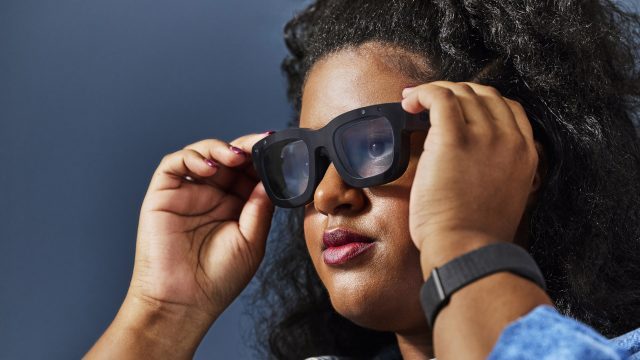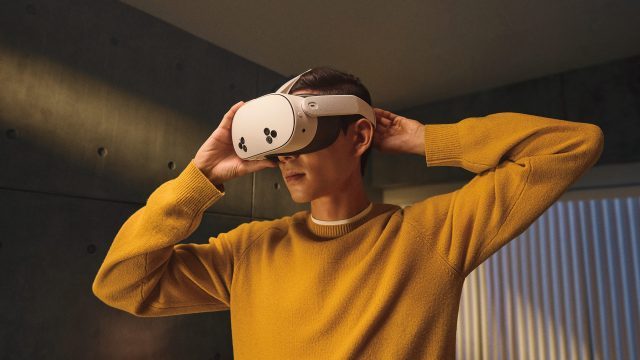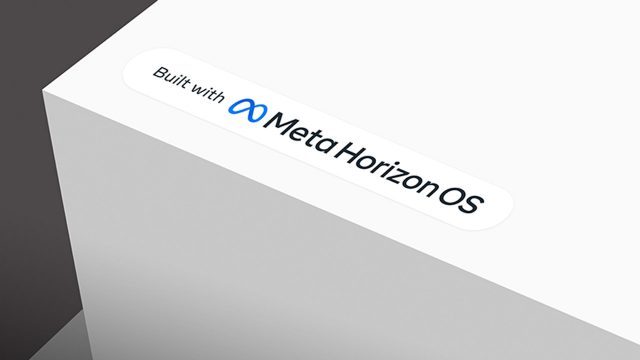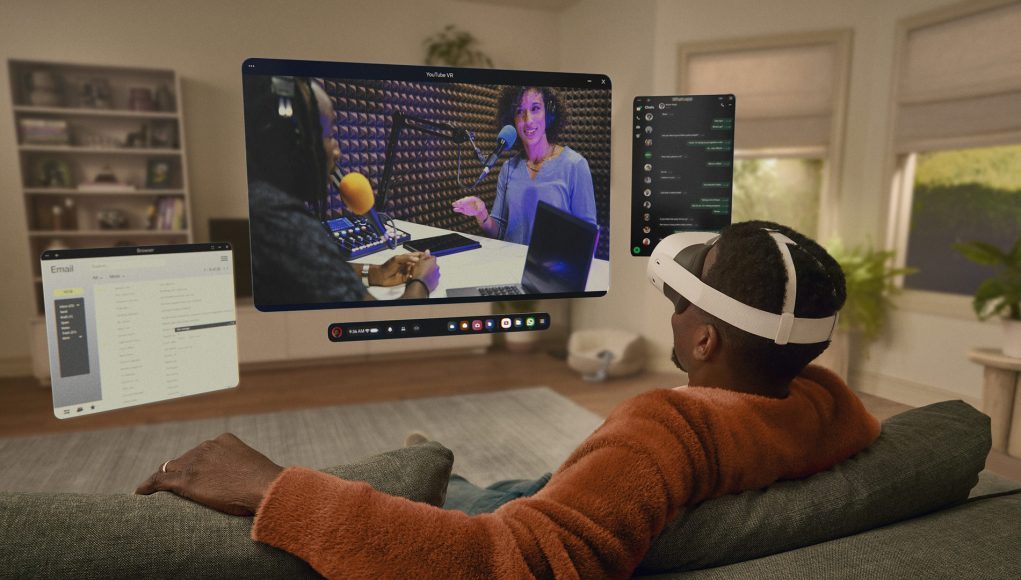Meta continues its reign as the XR industry’s dominant player, with its most recent moves signaling a shift into a new era for the company—and thus the industry at large. This year saw the introduction of the Meta Orion AR glasses prototype and the Quest 3S headset—two pieces of hardware that are not only crucial to Meta’s future but will be pivotal in shaping the industry’s direction as a whole.
Meta Orion AR Glasses Are a Flag in the Ground

The News
One of Meta’s most significant announcements this year was the unveiling of the Meta Orion AR glasses prototype. Meta has long been signaling its ambitions in the AR space, and the Meta Orion prototype represents a major step toward that vision. With a compact form-factor and an impressive 70-degree field of view, Meta is aiming to push the boundaries of what AR hardware can achieve.
Why It Matters
Meta’s Orion AR glasses stand as a benchmark for the state-of-the-art in AR glasses today. Unlike similarly sized AR devices—which suffer from a narrow field-of-view that make content appear constrained—Meta Orion’s 70-degree FoV is just scraping the boundary of ‘wide enough to be useful’. Achieving a compact form-factor and a wide field-of-view in the same package is crucial for making AR feel more seamless and practical in daily use.
It will be years yet before Meta ships something like Orion, but it’s an intentional ‘flag in the ground’ moment for the company.
Quest 3S Speeds the Transition Away from Quest 2

The News
Meta launched Quest 3S, a new addition to the Quest lineup that really should have launched alongside Quest 3 in the first place. Positioned as a more budget-friendly alternative to the flagship Quest 3, the Quest 3S comes with a lower price point but still offers significant improvements in performance and mixed reality capabilities compared to older devices like the Quest 2.
Why It Matters
In its marketing, Meta has been hyping mixed reality for years at this point. But the large population of Quest 2 headsets (which really aren’t great for MR) have undercut the company’s push into MR.
The Quest 3S is finally a new headset from Meta that’s comparable to what Quest 2 was in terms of affordability, while including reasonably good MR capabilities too.
With the Quest 2 becoming increasingly outdated, users and developers alike have been waiting for hardware that can keep up with more demanding VR experiences. The Quest 3S hits the sweet spot for many casual users, offering a balance between affordability and performance.
And finally Meta has a flagship game for its Quest 3 & Quest 3S hardware. Batman: Arkham Shadow (which is exclusive to these newer headsets), is just the thing to get VR gamers that are hanging on to Quest 2 to make the leap to newer hardware.
Ironically, the flagship game for these new “mixed reality” headsets (as Meta now usually refers to them) is a pure VR game. Maybe with the next headset launch the company can properly time a flagship MR app with its launch.
More Immersive and Useful Mixed Reality Apps

The News
This year Meta revealed that it will now grant developers access to camera data for creating mixed reality (MR) content. This change opens up new possibilities for how MR experiences are built and how users can interact with their environments through these experiences.
Why It Matters
For years Meta has held out on giving developers direct access to the headset’s cameras. That made it harder for developers to build interesting MR applications that properly integrate and interact with the world around the user.
In addition to Quest 3S helping to grow the population of Quest headsets with decent MR capabilities, this change also makes building MR applications a more attractive proposition for developers.
Ostensibly Meta had originally blocked direct camera access to preserve user privacy and prevent potential abuse by bad actors. Reversing that decision is risky; another privacy scandal is the last thing Meta wants its headsets to be known for.
New Tools for Developers to Bring ‘Spatial Computing’ to Quest

The News
This year Meta also introduced new tools to make it easier for developers to port both flat-screen and spatial computing applications to Quest devices. These tools are designed to streamline the development process, enabling developers to create more immersive XR content without requiring a steep learning curve.
Why It Matters
Meta’s headsets are great for gaming, but it wants them to be great at ‘spatial computing’ too. But getting developers to bring traditional apps to its platform has been a major hurdle for the company.
One of the biggest challenges traditional app developers face is moving from a flat screen modality to something that inherently exists in 3D. This generally requires a completely different set of tools that’s much more in the realm of game development than app development.
Meta’s new tools aim to simplify this process, allowing developers who are familiar with building flat-screen applications to bring their apps to the Horizon platform with minimal friction. This opens up the Quest platform to a wider range of applications, from 2D games and productivity tools to more immersive spatial experiences.
But Meta still faces an uphill battle with getting a critical mass of everyday apps onto its headset. The company has openly said it would love to bring the Play store (and all of its apps) to the headset, but it seems Google isn’t down to play ball. That’s likely because it’s busy working on its own XR strategy and doesn’t want to give Meta an upper hand.
New Headsets on the Horizon

The News
In a surprising move this year, Meta announced that it was planning to open up the Horizon OS to select partners who will make their own headsets that run the operating system.
Why it Matters
While Meta has made solid general-purpose headsets, the company believes the time is right for more specialized options. But rather than build those options itself, the company is enlisting help from companies that are already familiar with building hardware for someone else’s software.
While this could bring a wider range of headsets to market which retain access to Meta’s leading platform of content, the move shares a striking resemblance to Microsoft’s ill-fated VR play which enlisted major computer OEMs to build a round of VR headsets and then quickly lose interest.
Because Meta owns the Horizon platform, and subsidizes the cost of its own headsets, it’s difficult to understand how announced partners like Asus and Lenovo could hope to build a headset that’s meaningfully better than what Meta is already offering and compete with Meta on price. This has clearly been a struggle for HTC Vive which doesn’t have the money to burn to subsidize its hardware like Meta.
Meta may have already run into trouble with its announced partner LG, which was set to collaborate with Meta on a Horizon OS headset, but reportedly had second thoughts just weeks later.
– – — – –
Meta’s ability to burn billions in its pursuit of owning the XR space (or the “next computing platform” as Zuckerberg often calls it) means the company is the one primarily steering the ship. The moves Meta made this year are the beginning of a new era for the company (while most of the industry remains in tow).
While Apple’s entry into the space has already had notable influence on Meta’s XR trajectory, it won’t be until both companies are competing in the same price-class (and for the same users) that Meta will have to truly fight to maintain control of XR’s near-term future.







